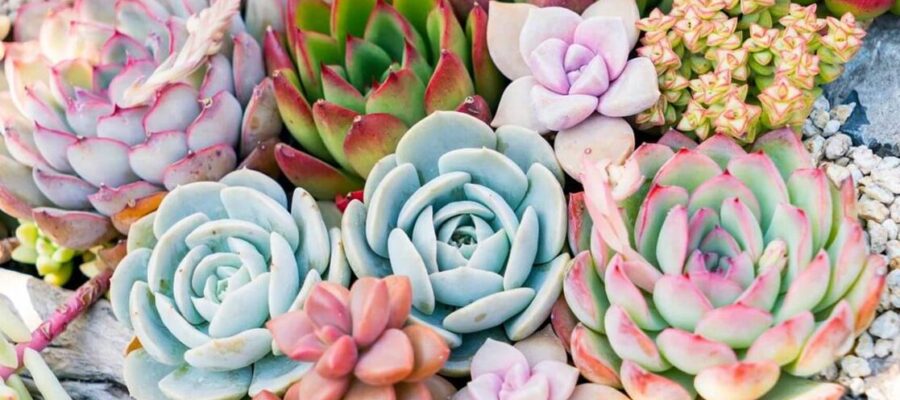You certainly heard about him. After all, fatty plants have become well known in recent years. These attractive plants are not only beautiful and versatile for ornaments, but also have unique qualities that make them simple to maintain.
However, find out exactly what are fatty plants and what types of fatty plants exist? In this article we will examine what you need to know about these interesting plants.
What are fatty plants?
Succulent are plants that have the ability to keep water in their leaves, stems or roots.. In fact, it is thanks to this feature that is able to survive in arid and dry climates, where the water is poor.
Succulent is a transversal feature of several families of plants, such as Crasuláceas. The reality is that there are about 50 families who have at least one kind of fatty plants. For example, the tuna, the Pitaya And aloe, despite being succulent plants, belong to very different families.

Characteristics of succulent plants
The fatty plants are known for their fleshy leaves.. This is its most common feature: «puffy» leaves, due to the amount of water capable of preserving.
However, The fatty plants are also available in an incredible variety of shapes, colors and sizes.. From small and compact plants to the trees that impose, there is a succulent that adapts to every taste and space.
Types of fatty plants
There are hundreds of types of fatty plants, each with its own characteristics and peculiarities. Among the most appreciated we have:
Echory
Succulent like this Echory They are known for their symmetrical rosettes of fleshy leaves. Furthermore, they have a variety of Impressive colorsFrom light green to intense purple. In this sense, the Echory It is a popular option for succulent agreements.
Sedum
Genre Sedum It is composed of low growth succulents. This, according to the species, can form dense rugs. Ideal for covering the floor of succulent gardens or even on green walls, the Sedum Also enters Large variety of shapes and colorsThis can vary from green to an intense red.
Crassula
Succulent like this Crassula They are known for their rounded and fleshy leaves And because they adapt well to different cultivation conditions. For example, the Crassula oval – known as a jade plant – it is one of the most popular fatty plants, thanks to his Exuberant aspect and easy maintenance..
How to grow succulent
Suculent are relatively easy to cultivate plants, but it is important to provide them with the right conditions for their healthy growth.. Therefore, some essential suggestions for the cultivation of fatty plants are:
Luz
Suculent loves direct and brilliant sunlight.. So be sure to put them in a place where they receive at least six hours of sunlight per day. If succulent cultivation inside, the ideal location will be close to a window with a lot of direct light.
Alone
Succulent prefers sandy and well drained soils.. Therefore, it is necessary to use a specific substrate for fatty plants or modify the existing soil with sand, peat or perlite.
Novel
Adapted to dry climates, Grasse plants do not need a lot of water. In fact, it is essential to avoid wetting the roots. Therefore, water only when the ground is completely dry. It is better to water less frequently than the water too much.
Temperature
These plants are very resistant and tolerate high temperatures.. However, avoid exposing succulent to extreme temperatures, in particular frost. If they are outdoors during the winter, cover them with protective fabric or place them inside.
Curiosity about fatty plants
Well, in addition to the very specific characteristics of these plants, Suculent has other interesting data.:
Symbolism
It is usually associated with a positive symbolism. For example, in Asian culture they represent prosperity and durability. Some species, such as Jade plants, are known as money plants. At the same time, The fatty plants are considered symbols of good luck.Thanks to its ability to retain water.
Natural protection
Some succulents have a hilly layer on their leaves.Epicutical wax. This coating acts as a natural sun protection. Therefore, it is important handle With particular care to avoid eliminating this coating.
Diversity
The diversity of existing fatty plants is impressive. There are all the shapes, colors and imaginable dimensions. As a child and delicate to the giant and imposing, variety of fatty plants It is truly surprising.
Have succulent at your home
And now everything has become more evident. What are fatty plants? Beautiful, attractive and also simple to take care, they are an excellent option for those who are starting in the field of gardening. With these suggestions and information, you will surely feel interest and you will want to cultivate your fatty plants. So accept this challenge and start having a little nature at your home!
Latest items published

How to cook winter radishes?

FLOWER CLOVE-MARITIMA ARMERIA: Cultivation and care

The importance of bees for pollination

The final guide on how to plant, take care and discover the origin of Coleonema

The wisdom of the garden: the influence of popular proverbs on the plantation and the care of natural flowers

Let's discover the rose and its secrets: the May plant

Friar Kiss – Balsamin Family

Amarilis – Learn to take care (Hippeastrum Hybridum)

CHANTRIERI NOC – The bat flower has flowers resemble the bats


